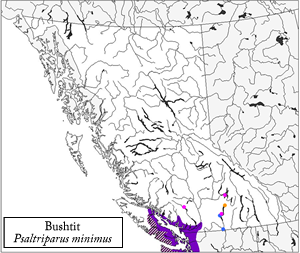The behaviour, vocalizations, size, and plumage of this species are all distinctive, and it is unlikely to be confused with any other species in British Columbia.
| Foraging flocks, as well as pairs and single individuals, give a nearly continuous chatter of soft, often burry twitterings that incorporate a wide variety of notes, including sharp, scraping skrrti ti ti calls, dry spik notes, and high, thin, scraping tseeez tzee tzee tzee calls given in a long, slightly descending series. Flocks give a loud, high, clear , descending tsididididididi or sre-e-e-e-e-e-e-e when an aerial predator (owl, hawk) flies overhead. Source: Sibley (2000); Sloane (2001) |
Courtship
Pair bonds are often maintained for more than one year, with new pairs being formed in late winter (late January or February). During courtship, the male chases and pursue the female while uttering soft contact calls, subsequently pecking the female near the cloaca to stimulate copulation.
Nest
Nest construction begins early in the year, with some nests being initiated as early as February; most nests are built during March and April. Both sexes contribute to the construction of the nest, which occurs over a period of 2-5 weeks. The nest is a distinctive, pendulous, gourd-shaped “sock” 20-25 cm in length with a small horizontal entrance hole near the top. Nests are placed in coniferous or (more commonly) deciduous trees and shrubs in brushy areas or along forest edges. The nest is typically attached at the top to several small twigs and hangs vertically; nest heights range from 0.6-15 m, with most nests occurring between 2-3.5 m above the ground. The nest consists of tightly, intricately woven strands of moss, lichens, twigs, leaves, cocoons, rootlets, spider webs, fine grasses, hair, and plant fibres. The interior of the nest is lined with finer materials, including plant down, hair, and feathers. Nests are often used for more than one season, and replacement nests are often created from the remains of nests that have been destroyed by weather or predation.
Eggs
A single clutch of (4) 5-7 (8) smooth, slightly glossy, white eggs is laid between mid-March and mid-July, with most clutches initiated between mid-April and mid-May (later clutches include both replacement clutches as well as second [and even third] broods). More than one female may occasionally lay eggs in a single nest, as evidenced by clutches of up to 15 eggs in some nests. Both sexes incubate the eggs for a period of 12-13 days before hatching. This species is rarely parasitized by the Brown-headed Cowbird. Eggs occur in British Columbia between mid-March and late July.
Young
The young are naked and fully altricial at hatching, with scant hair-like greyish-white down soon appearing. The nestlings are tended by both parents and remain in the nest for 14-18 days before fledging. Fledglings then remain associated with (and tended by) the parents for an additional 8-14 days before becoming fully independent. Nestlings and dependent fledglings occur in British Columbia between mid-April and mid-August, although most occur between early May and mid-June.
Source: Harrap and Quinn (1995); Baicich and Harrison (1997); Campbell et al. (1997); Sloane (2001)
|
The Bushtit forages in pairs or small to large (10-40+ individuals) flocks throughout the year, and is rarely encountered as single individuals. Although flocks sometimes associate with other small passerines (kinglets, chickadees, nuthatches), they tend to remain somewhat separate from these other species and are more commonly encountered as single-species groups. Bushtits feed on a wide variety of small insects and spiders, which are gleaned from leaves, twigs, and branches of brushy vegetation. A relatively small amount of vegetable material (seeds, berries, small galls) is also included in the diet, but typically comprises less than 20% of all foods taken. Flocks often visit feeding stations, especially in suburban environments, where they commonly swarm suet feeders en masse.
Source: Sloane (2001)
|
|

